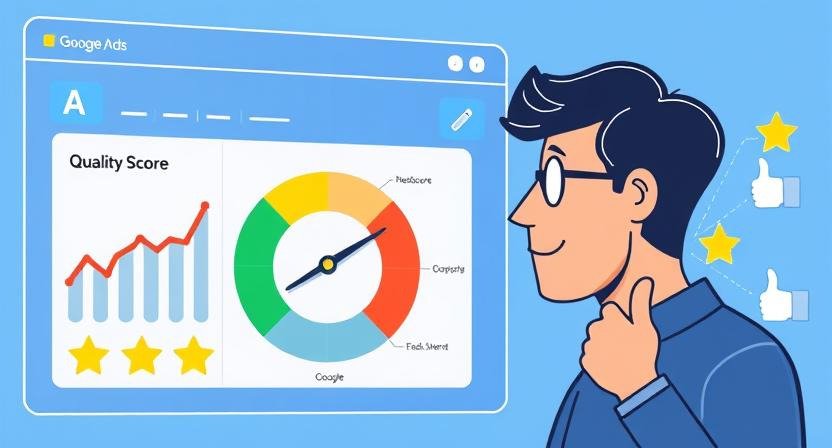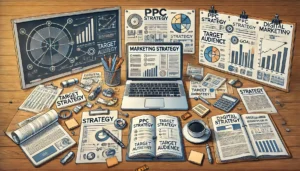- What Is Google Ads Quality Score?
- Why Quality Score Matters in Your Campaigns
- The Three Key Components of Quality Score
- How Google Measures These Components
- How to Check Your Quality Score in Google Ads
- Ways to Improve Your Expected CTR
- Making Your Ads More Relevant
- Creating Better Landing Pages
- How Quality Score Helps You Save Money
- Common Mistakes That Hurt Your Quality Score
- Tools and Tips for Tracking and Optimizing Quality Score
- Real Examples of Quality Score in Action
- How Long It Takes to Improve Your Quality Score
- Myths and Misunderstandings About Quality Score
- Frequently Asked Questions (FAQs)
- Conclusion: Quality Score Is Worth the Effort
What Is Google Ads Quality Score?
Simple Definition and Purpose
Google Ads Quality Score is like a grade your ads get. It tells you how good your ads are in Google’s eyes. The score is from 1 to 10, and the higher, the better. A high score means your ad is helpful and matches what people are searching for. Google uses this score to decide where your ad shows up and how much you pay for it.
Why Google Uses It
Google wants users to have a good experience. If ads are useful and match the search, users are happier. That’s why Google rewards ads that perform well with better placements and lower costs. Quality Score helps Google keep the ads high-quality for everyone.
Why Quality Score Matters in Your Campaigns
Impact on Ad Rank
Your Quality Score affects your Ad Rank, which decides where your ad appears on the search results page. Even if your competitors bid more money, your ad might still show above theirs if your Quality Score is higher.
How It Affects Cost-Per-Click (CPC)
A higher Quality Score can lower your cost-per-click. That means you pay less every time someone clicks your ad. This helps stretch your budget and get more value from your ad spend.
The Three Key Components of Quality Score
Expected Click-Through Rate (CTR)
This measures how likely it is that someone will click on your ad. If your ad usually gets clicked when shown, that’s a good sign to Google.
Ad Relevance
Ad Relevance checks how closely your ad matches the keywords you’re targeting. If someone searches “running shoes,” and your ad is about sneakers, that’s a match.
Landing Page Experience
Once someone clicks your ad, they land on your website. If the page is helpful, loads fast, and matches the ad, Google gives you a better score.
How Google Measures These Components
Data Google Looks At
Google looks at real data: how often people click, how long they stay on your site, if they quickly leave (bounce rate), and more. It’s all about the user’s experience.
User Signals and Behavior
Google tracks what users do. If users interact with your ad and stay on your site, those are good signs. These behaviors help boost your Quality Score over time.
How to Check Your Quality Score in Google Ads
Step-by-Step Instructions
- Log in to your Google Ads account.
- Go to your campaigns and choose a keyword.
- Add the “Quality Score” column by customizing the column view.
- You’ll now see a score from 1 to 10 next to each keyword.
Understanding the Scores You See
- 8–10: Excellent
- 5–7: Average
- Below 5: Needs work
If you see a low score, don’t worry—it just means there’s room to grow.
Ways to Improve Your Expected CTR
Writing Catchy Headlines
Use strong, clear headlines. Ask questions. Use numbers. For example:
- “Looking for Budget-Friendly Laptops?”
- “Top 10 Tools for DIY Repairs”
Catchy headlines grab attention and increase clicks.
Using Clear Calls to Action (CTAs)
Tell people what to do:
- “Shop Now”
- “Get a Free Quote”
- “Book Your Demo Today”
A good CTA guides the user and boosts your CTR.
Making Your Ads More Relevant
Match Ads to Keywords
Use the exact words your audience types into Google. If your keyword is “vegan dog food,” make sure those words are in your ad text too.
Avoid Misleading Text
Don’t promise things you can’t deliver. If your ad says “Free Shipping,” make sure it’s true. Honest ads keep users happy—and Google too.
Creating Better Landing Pages
Easy Navigation and Fast Load Times
Nobody likes a slow or confusing website. Make sure:
- Your page loads in under 3 seconds.
- It works well on phones and tablets.
- It’s easy to click and scroll.
Keeping Content Relevant
Make sure your landing page matches your ad. If your ad says “Affordable Dog Beds,” your landing page should be all about dog beds, not cat trees.
How Quality Score Helps You Save Money
Lower CPC for Higher Scores
A higher Quality Score means Google rewards you with lower costs per click. You spend less but still reach more people.
Better Return on Ad Spend (ROAS)
Since your ads cost less and perform better, your return on ad spend goes up. This means more value for every dollar you spend.
Common Mistakes That Hurt Your Quality Score
Overusing Keywords
Stuffing your ad with the same keyword too many times makes it look spammy. Use it naturally.
Irrelevant Landing Pages
If someone clicks your ad and ends up on a page that doesn’t match, they’ll leave fast. That’s bad for your score. Always keep things relevant.
Tools and Tips for Tracking and Optimizing Quality Score
Using Google Ads Reports
Set up reports in Google Ads to track Quality Score trends over time. Look at which keywords are dragging your score down.
Setting Up A/B Testing
Test two versions of your ad. See which one gets more clicks and better results. Keep the one that works best.
Real Examples of Quality Score in Action
Before and After Campaign Results
One small business had a Quality Score of 4. After improving their ad copy and fixing their landing page, it jumped to 8. Their CPC dropped by 30%, and they got more leads.
What Worked and What Didn’t
What helped:
- Better CTAs
- Using keywords in ad text
- Fast-loading pages
What didn’t:
- Vague offers
- Broken links
- Too many keywords jammed in
How Long It Takes to Improve Your Quality Score
Short-Term vs. Long-Term Changes
Some changes help fast—like fixing headlines or CTAs. Others take time, like improving your landing page or CTR. Be patient. Quality Score is a long game.
Myths and Misunderstandings About Quality Score
“It’s All About CTR” and Other Myths
CTR is important, but it’s not everything. Ad relevance and landing page experience matter just as much. Don’t focus on only one part.
Frequently Asked Questions (FAQs)
Q1: What is a good Quality Score?
A score of 7 or higher is considered good. Aim for 8–10 if possible.
Q2: Can Quality Score affect ad placement?
Yes, it directly affects where your ad appears.
Q3: Does Quality Score affect how much I pay?
Yes! Higher scores often mean lower CPCs.
Q4: How often does Google update Quality Score?
It updates regularly based on user behavior and your ad performance.
Q5: Is Quality Score the same for all keywords?
No. Each keyword has its own score.
Q6: Can I still succeed with a low score?
It’s possible, but it costs more. Improving your score helps you succeed with less spend.
Conclusion: Quality Score Is Worth the Effort
Improving your Google Ads Quality Score is one of the smartest moves you can make. It helps your ads show up more often, costs you less, and brings in better results. Start by focusing on your ad copy, making your landing pages more helpful, and staying honest and relevant. With steady effort, you’ll see real improvement.




